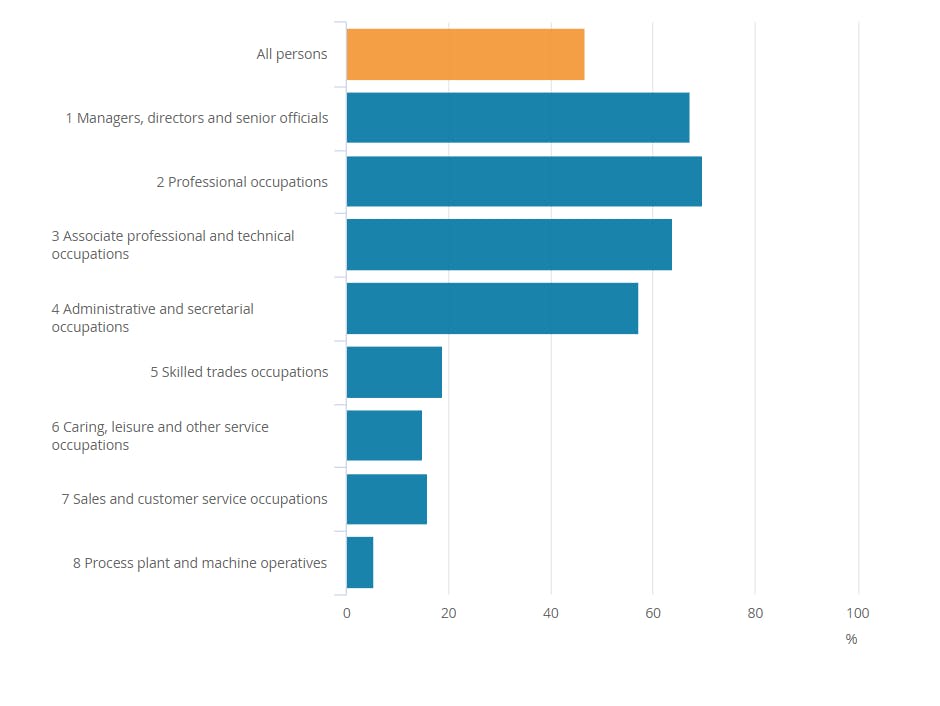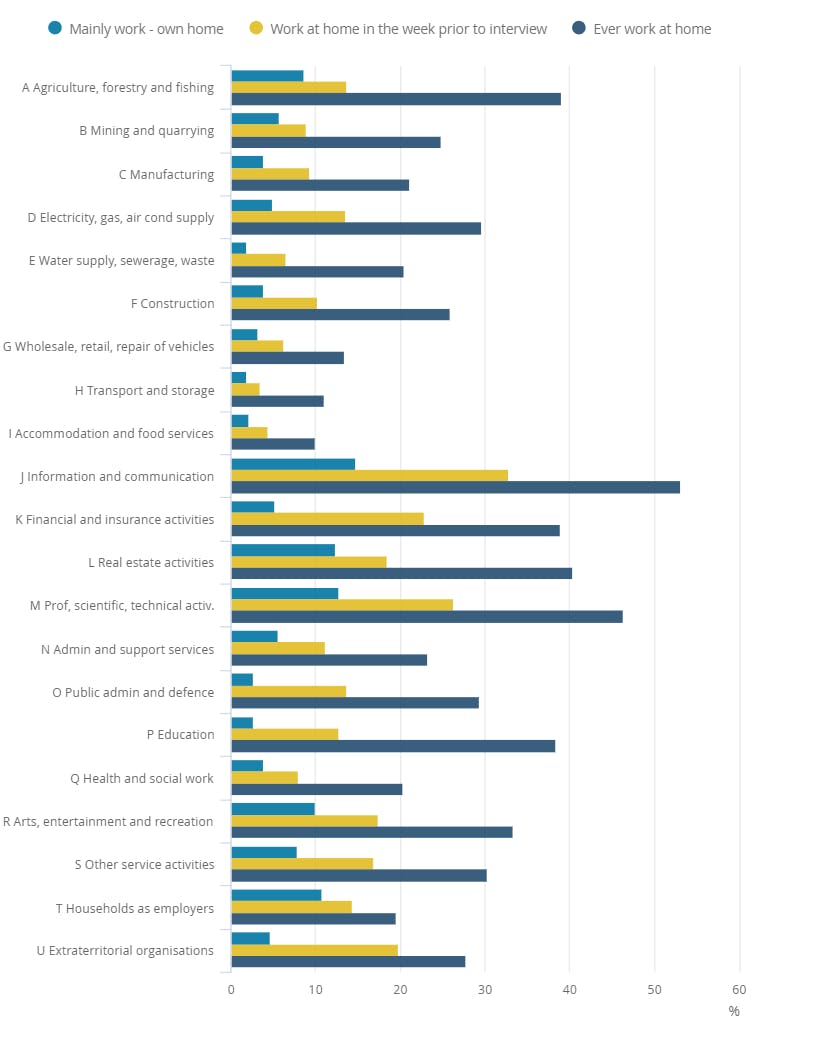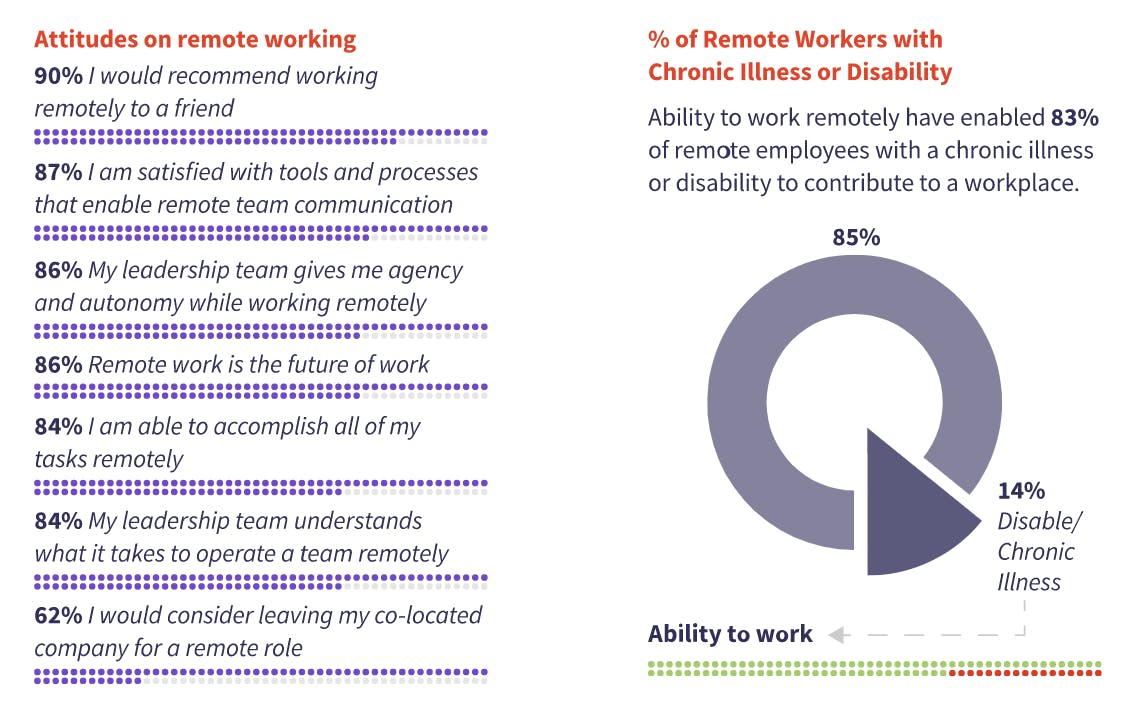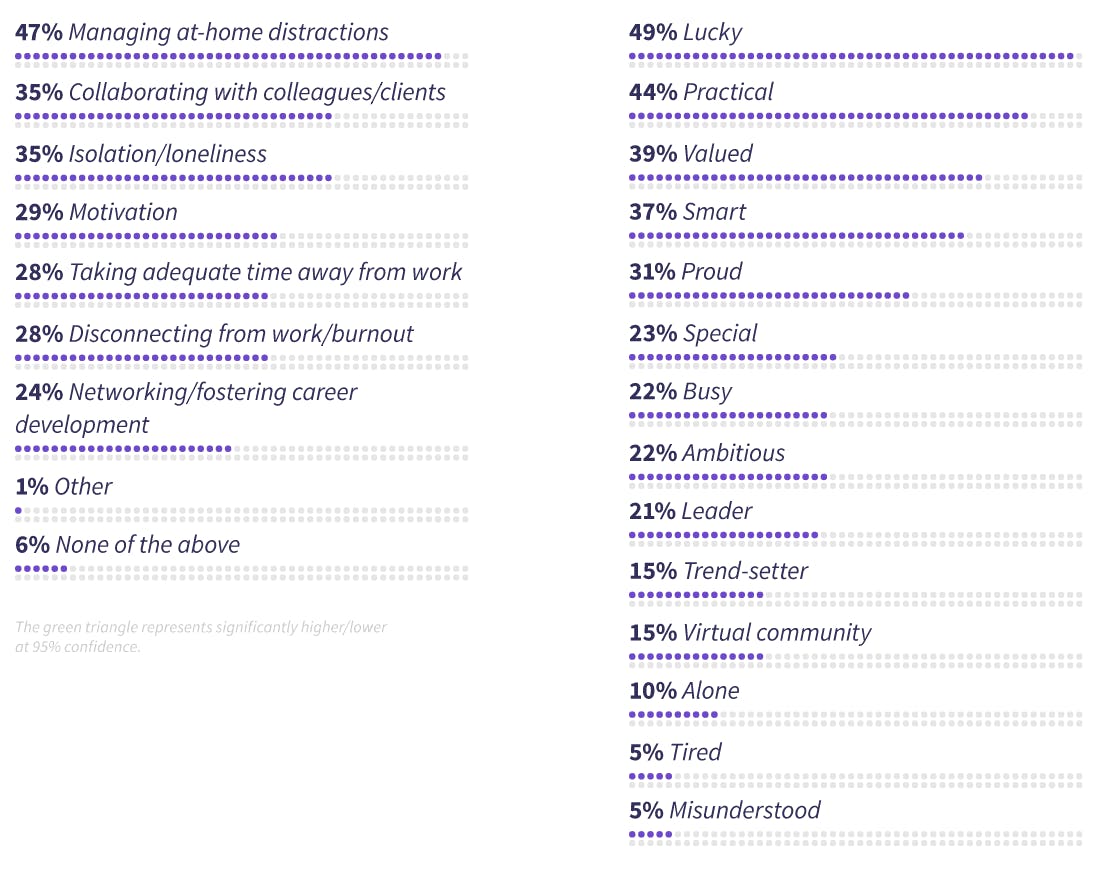The future for scaleup businesses is ‘remote first’, here’s why office space is now optional
On the 16th March 2020, many of us were sitting at home awaiting statements from central government. This was followed by a series of televised statements, where Boris Johnson, and his team, resolutely asked us to stay at home to save lives.
After 5 months, there is now a wealth of data which indicates business readiness and response for remote working.
We have detailed below what this data shows, and what this may indicate for the future. I’ve tried to separate the impact of Working from Home (WFH) from COVID, but it is tricky!
Operational Impact
An ONS report shows a breakdown of occupations and what percentage of those people are working from home:
It states “Occupations requiring higher qualifications and experience were more likely to do some work at home”

This could indicate that roles 5-8 involve tasks which are far harder to complete remotely (e.g. working machinery), or sectors with these roles are less ready for remote working.
However, it does seem that some portion of these roles allow working from home, or entire roles in these occupations.
So the question is: Do the roles/tasks which are theoretically completable remotely, have other barriers which prevent someone doing this remotely?
E.g., Does a reporting element require the use of onsite paper or computers? Would eliminating that requirement through automation generate a cost saving for your business?
ONS data from 2019 suggests that many industries are capable of working remotely:

Given that many industries and roles have people which work from home, does that suggest an office is not essential to the way we work?
Could there be other barriers which create operational challenges aside from not using an office?
We believe so. In our post 21 Indicators that lack of tech is slowing scaleup growth, we detail that a number of prevalent operational challenges our clients have, are solvable by improving the following areas:
- Adoption of technology & automation of processes
- Use of data to drive decision making
- Continuous Digital Improvement
- Process documentation
Restrictions include:
- Using onsite software, like Sage50 (consider migrating to cloud software like Xero)
- “Adding more people makes it slower”, is likely inadequate process documentation, and this may be made worse when the team is remote
- Physical interaction is required, but could be avoided – like collecting wet signatures
If this is done correctly (whilst also considering cyber security), we believe working from home vs in the office becomes a cultural choice, not an operational restriction.
By properly digitising the business and its processes, remote working as a possibility becomes a natural side effect.
How do I know people are working?
A common reaction to remote working is ‘how do I know people are working?’. It’s a valid question, and the truthful answer is, that at any given moment, you don’t. But, is that different when you’re in the office?
Would a better question be, “how do I track people’s output?”
Would there be more mutual trust if it is mutually understood whether or not someone is hitting objectives?
It’s important to collect data on output & performance, to allow for this assurance, and understand business performance as a whole.
Recruitment
A recent report shows that 32% of office workers expect to at least partially work from home after lockdown, with 44% of Londeners wanting to make that shift.
This is up from just 10% the year before.
Before lockdown, less than third of people reported they had worked from home, and in April this increased to half of people.
With a growing number of people working from home, and a growing expectation that it be permitted, will scaleup businesses which do not offer this be at a recruitment disadvantage?
Gitlab’s report in March 2020: The Future of Work is Remote suggests that 36% of remote workers would search for a new role elsewhere, if remote working was no longer possible. Will businesses that offer remote during COVID, and then revoke that, see staff leave?
With hiring, we’ve brought in two new people since being remote (hi Jonny and Phil!) – it went well. It was different, but not worse. We’d see bigger improvements by evolving our process, rather than mandating in-person meetings.


Wellbeing & Performance
“The UK workforce is in the grip of a mental health epidemic. At the beginning of this year, global consultancy Deloitte estimated that a sixth of UK workers were experiencing a mental health issue at any one time, costing UK businesses between £42-45 billion a year through lost days and reduced productivity. Thanks to the coronavirus-imposed lockdown, that figure – already 16 per cent higher than the one identified in the landmark Stevenson-Farmer review into mental health in the workplace conducted in 2017 – is expected to continue to grow.”
Regarding returning to the office:
“A survey carried out by the Chartered Institute of Personnel and Development (CIPD) as lockdown measures started to ease, found that one in four employees was experiencing anxiety about returning to work, while one in three was anxious about the daily commute”
Our friends at Art Health Solutions have reported that:
- Over a quarter of employees (26%) reported feeling isolated
- 24% found that being able to collaborate with their team was challenging
- 21% of employees reported that they enjoyed the flexibility that working from home afforded them
- 25% reported not having to commute to the office as a big benefit of home working
- Increased sleep quality and memory performance
Art Health Solution recommend gathering this data for your organisation now, to empower decision making later.
Do these metrics align with your business? Would this adjust your thinking on office space and the way you operate?
Is mental health a larger concern with/without the office?
Gitlab’s report in March 2020: The Future of Work is Remote displays the following around challenges and feelings:

Collaboration
There is nothing like being in the office, with a pot of filtered coffee, fruit, pastries, and an arguably excessive number of whiteboards and sticky notes – this we will miss.
We ran our show and tells (product demonstrations) and discovery sessions largely in person with local clients. Jumping on the train to London was a blessing and a curse, but finishing the day with some food and a few drinks makes it worthwhile.
Whiteboarding software Miro, and Teams for video calls makes this functionally possible remotely, and it works well. Is it as good as physically being there? No, I don’t believe so.
Is remote collaboration more time efficient? We no longer need to travel, thus it seems so (anecdotally), but how might that impact the relationships of the people communicating?
Communication
It has been argued (and criticized) that when communicating feelings, words and tone account for only 55% of the message.
Are we at a significant communication disadvantage with no video? What about without a physical presence, and unable to see body language?
Does video cut it? Trello summarises how to be better at video, and why it is especially important for difficult or complex conversations. Critical feedback (meant to be constructive) may appear disparaging and not useful when done via chat or voice.
Are 1-2-1s less effective remotely? Do teams lose something if they can’t have lunch together, or a few beers?
We have a daily morning standup which last 15 minutes (say what you did yesterday and will do today, and what’s blocking work), as well as an optional catchup call in the afternoon (no work chat allowed!), just to keep in touch, which does help with the isolation. Skribbl is a regular occurrence during the catchup to unwind a little.
Are there benefits?
Absolutely. I believe the asynchronous element of the communication is more efficient for all involved, especially for who ever is on the receiving end. How frustrating is it to be mid task and be interrupted? Communicating via online chat like Slack first, and moving to video chat if that develops into something more complex reduces opportunity for interruption.
What is remote first?
Remote first instils that working remotely is the default, where other means of working are secondary and optional. Processes, technology, and culture align with this and support it.
Remote first doesn’t mean ‘remote only’, just that it’s the default choice. It means that if some people are together, and others are remote, the people who are remote are still able to be involved.
The data collected for this article suggests improvements across multiple business functions when remote working is utilised. However, we’re human after all, remote only has its drawbacks regarding wellbeing and communication.
Remote first strikes the balance. It means:
“work remotely by default, collaborate in person when it’s better”
Office space could then be orientated towards collaboration, rather than pointless congregation. People might go in simply to be around other people, but the key being that it’s entirely optional.
Scaling businesses like Gitlab class themselves as all remote, and have a team of 1300+, and were doing this before it was cool, as were these other businesses. Of all remote workers, employees of tech businesses make up the biggest segment. This indicates that it is not only possible, but businesses have scaled massively using the practice.
Remote first may be less forgiving of lack of documentation than being around each other in an office, and it requires the correct cloud software in place to digitise these processes.
What will Wubbleyou do?
Before COVID, Wubbleyou was ‘remote friendly’, we had a policy which staff exercised a couple of days a week.
During COVID, we went ‘remote only’, we terminated the lease for our offices, having not used them for 5 months.
Our future is ‘remote first’.
We will in the future create new space for our people. The space is to be used because people want to be there, or because they see a benefit in face to face communication (or whiteboards and coffee).
People are free to work and collaborate in that space, but only when it’s better than working remotely.
Conclusion
The tech sector has been moving in this direction for some time, with an increasing number of techies seeing remote working as an expectation and not a benefit, and why not? It works.
Has COVID turbo charged that direction of travel? Are other industries likely to see similar expectations from their clients and staff?
It seems likely. Given the data, businesses which are not adopting remote working as a standard post COVID, could be at a severe operational, commercial and resourcing disadvantage against those which do.
Scaleup businesses which are already pushing hard against boundaries in all directions may see a slow in growth, or see themselves outcompeted. Some of the same operational challenges faced by a scaleup are the same which make remote working harder (e.g. lack of tech and process documentation).
This is also not a new concept, with some tech businesses embracing this as early as 5 years ago.
Thinking beyond COVID. now is the time for the rest of us to catch up and embrace this dynamic for the long term.
Scaling businesses already have the advantage, they’re already used to moving quickly and with agility. Is this another opportunity on which to capitalise?

